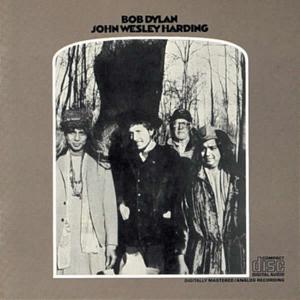
John Wesley Harding (1967)

1. John Wesley Harding
2. As I Went Out One Morning
3. I Dreamed I Saw St. Augustine
4. All Along the Watchtower
5. The Ballad of Frankie Lee and
Judas Priest
6. Drifter's Escape
7. Dear Landlord
8. I Am a Lonesome Hobo
9. I Pity the Poor Immigrant
10.The Wicked Messenger
11.Down Along the Cove
12.I'll Be Your Baby Tonight
In the aftermath of Dylan’s mid-sixties creative detonation—culminating in the twin high-water marks of Highway 61 Revisited and Blonde on Blonde—few could have anticipated the quietude of John Wesley Harding. Released at the close of 1967, it arrived not with a thunderclap, but a whisper. Where psychedelia and sonic excess had become the new norm, Dylan responded with restraint: a sparse, subdued meditation that eschewed ornamentation and rewrote the rules once again.
Though often mislabeled a “country” album, John Wesley Harding is in truth something subtler and more enigmatic. If there is any genre marker here, it leans more towards “western”—not in musical convention, but in atmosphere and narrative form. Dylan populates the record with outlaws, pilgrims, saints, and drifters. These are songs of moral reckoning and quiet parable, set to arrangements that border on austere. It is, above all, a work of recalibration.
Gone is the amphetamine blur of Subterranean Homesick Blues or the acid wit of Leopard-Skin Pill-Box Hat. In their place, Dylan offers restraint. Tracks such as I Dreamed I Saw St. Augustine and Dear Landlord are nearly ascetic in their composition. The title track itself sets the tone: a cryptic ballad of the eponymous outlaw that reads like scripture and plays like a fireside legend.
The album’s greatest anomaly—and its most famous export—is All Along the Watchtower. Stark and elliptical in Dylan’s own rendering, it would be Jimi Hendrix’s searing, electric reimagining that would lift the song to immortality. Yet even in its original incarnation, it exudes a foreboding gravity unmatched elsewhere in Dylan’s catalogue.
I’ll Be Your Baby Tonight closes the album with disarming sweetness, offering a rare moment of romantic clarity in a record otherwise steeped in allegory and biblical cadence. It is perhaps the only track that hints at the full embrace of Nashville stylings that Dylan would explore more explicitly on his next outing.
John Wesley Harding is not an album that demands attention; it rewards patience. For some, its uniform tone and minimalist aesthetic border on monotonous. But for those attuned to its wavelength, it reveals a depth of focus and control unmatched by most of its contemporaries. In the context of Dylan’s career, it stands as one of his most daring maneuvers—not for its volume, but for its silence.
Go back to the main page
Go To Next Review